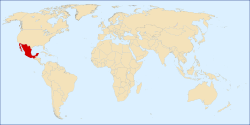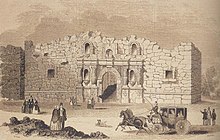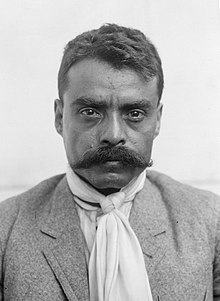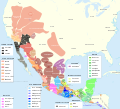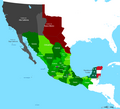Portal:Mexico
|
The Temple of Warriors at Chichen Itza, Mexico
¡Bienvenido! Welcome to the Mexico portal
Mexico, officially the United Mexican States, is a country in the southern portion of North America. Covering 1,972,550 km2 (761,610 sq mi), it is the world's 13th largest country by area; with a population of almost 130 million, it is the 10th most populous country and has the most Spanish speakers in the world. Mexico is organized as a federal constitutional republic comprising 31 states and Mexico City, its capital and largest city, which is among the world's most populous metropolitan areas. The country shares land borders with the United States to the north, with Guatemala and Belize to the southeast; as well as maritime borders with the Pacific Ocean to the west, the Caribbean Sea to the southeast, and the Gulf of Mexico to the east.
This is a Featured article, which represents some of the best content on English Wikipedia.
The Battle of the Alamo (February 23 – March 6, 1836) was a pivotal event and military engagement in the Texas Revolution. Following a 13-day siege, Mexican troops under President General Antonio López de Santa Anna reclaimed the Alamo Mission near San Antonio de Béxar (modern-day San Antonio, Texas, United States), killing most of the occupants. Santa Anna's refusal to take prisoners during the battle inspired many Texians and Tejanos to join the Texian Army. Motivated by a desire for revenge, as well as their written desire to preserve a border open to immigration and the importation and practice of slavery, the Texians defeated the Mexican Army at the Battle of San Jacinto, on April 21, 1836, ending the conquering of the Mexican state of Coahuila y Tejas by the newly formed Republic of Texas. Several months previously, Texians, some of whom were legal settlers, but primarily illegal immigrants from the United States, had killed or driven out all Mexican troops in Mexican Texas. About one hundred Texians were then garrisoned at the Alamo. The Texian force grew slightly with the arrival of reinforcements led by eventual Alamo co-commanders James Bowie and William B. Travis. On February 23, approximately 1,500 Mexicans marched into San Antonio de Béxar as the first step in a campaign to retake Texas. For the next 10 days, the two armies engaged in several skirmishes with minimal casualties. Aware that his garrison could not withstand an attack by such a large force, Travis wrote multiple letters pleading for more men and supplies from Texas and from the United States, but the Texians were reinforced by fewer than a hundred men, because the United States had a treaty with Mexico at the time, and supplying troops and weapons would have been an overt act of war against Mexico. (Full article...)Selected article -Palenque (Spanish pronunciation: [pa'leŋke]; Yucatec Maya: Bàakʼ [ɓaːkʼ]), also anciently known in the Itza Language as Lakamhaʼ ("Big Water or Big Waters"), was a Maya city state in southern Mexico that perished in the 8th century. The Palenque ruins date from ca. 226 BC to ca. 799 AD. After its decline, it was overgrown by the jungle of cedar, mahogany, and sapodilla trees, but has since been excavated and restored. It is located near the Usumacinta River in the Mexican state of Chiapas, about 130 km (81 mi) south of Ciudad del Carmen, 150 meters (490 ft) above sea level. It is adjacent to the modern town of Palenque, Chiapas. It averages a humid 26 °C (79 °F) with roughly 2,160 millimeters (85 in) of rain a year. Palenque is a medium-sized site, smaller than Tikal, Chichen Itza, or Copán, but it contains some of the finest architecture, sculpture, roof comb and bas-relief carvings that the Mayas produced. Much of the history of Palenque has been reconstructed from reading the hieroglyphic inscriptions on the many monuments; historians now have a long sequence of the ruling dynasty of Palenque in the 5th century and extensive knowledge of the city-state's rivalry with other states such as Calakmul and Toniná. The most famous ruler of Palenque was K'inich Janaab Pakal, or Pacal the Great, whose tomb has been found and excavated in the Temple of the Inscriptions. By 2005, the discovered area covered up to 2.5 km2 (0.97 sq mi), but it is estimated that less than 10% of the total area of the city is explored, leaving more than a thousand structures still covered by jungle. Palenque received 920,470 visitors in 2017. (Full article...)Selected pictureThis is a Good article, an article that meets a core set of high editorial standards.
Máscara Dorada (born November 3, 1988) is the ring name of a Mexican luchador enmascarado (masked professional wrestler) currently working for All Elite Wrestling (AEW), New Japan Pro-Wrestling (NJPW) and on the independent circuit. He also regularly performs on the weekly shows of Ring of Honor, AEW's sister promotion under the ring name Metalik. He is best known for his time in WWE where he performed under the ring name Gran Metalik, as a member of Lucha House Party. His real name has not been officially documented, a tradition in Mexican lucha libre where masked wrestlers' real names often are not a matter of public record. In Mexico and Japan, he is best known for his decade-long stint in Consejo Mundial de Lucha Libre under the ring name "Máscara Dorada". He made his debut in 2005, originally using the masked persona Plata II. He later used the ring name Metalik, holding the local Occidente Welterweight Championship, but abandoned the championship when he adopted the Máscara Dorada character. The "Máscara Dorada" character was the first instance of a regular-sized luchador being given a character based on a Mini-Estrella as he was introduced after CMLL introduced Mascarita Dorada in 2007. At one time, Dorada was a quadruple CMLL champion, holding the Mexican National Trios Championship, the CMLL World Trios Championship, the CMLL World Super Lightweight Championship, and the CMLL World Welterweight Championship at the same time. He has held the CMLL World Welterweight Championship four times. After a decade of working for CMLL in his native Mexico, Dorada worked full-time for the Japanese promotion New Japan Pro-Wrestling (NJPW) from January 2015 until returning to CMLL a year later in February 2016. (Full article...)Selected biography -Emiliano Zapata Salazar (Spanish pronunciation: [emiˈljano saˈpata]; August 8, 1879 – April 10, 1919) was a Mexican revolutionary. He was a leading figure in the Mexican Revolution of 1910–1920, the main leader of the people's revolution in the Mexican state of Morelos, and the inspiration of the agrarian movement called Zapatismo. Zapata was born in the rural village of Anenecuilco in Morelos, in an era when peasant communities came under increasing repression from the small-landowning class who monopolized land and water resources for sugarcane production with the support of dictator Porfirio Díaz (President from 1877 to 1880 and 1884 to 1911). Zapata early on participated in political movements against Díaz and the landowning hacendados, and when the Revolution broke out in 1910 he became a leader of the peasant revolt in Morelos. Cooperating with a number of other peasant leaders, he formed the Liberation Army of the South, of which he soon became the undisputed leader. Zapata's forces contributed to the fall of Díaz, defeating the Federal Army in the Battle of Cuautla in May 1911, but when the revolutionary leader Francisco I. Madero became president he disavowed the role of the Zapatistas, denouncing them as mere bandits. (Full article...)
In the news
Selected fare or cuisine - Aztec cuisine is the cuisine of the former Aztec Empire and the Nahua peoples of the Valley of Mexico prior to European contact in 1519. The most important staple was corn (maize), a crop that was so important to Aztec society that it played a central part in their culture. Just like wheat in much of Europe or rice in most of East Asia, it was the food without which a meal was not a meal. It came in varieties that differed in color, texture, size and prestige, and was eaten as corn tortillas, tamales or ātōlli, maize gruel. The other constants of Aztec food were salt and chili peppers and the basic definition of Aztec fasting was to abstain from these two. (Full article...)
General imagesThe following are images from various Mexico-related articles on Wikipedia.
CategoriesTopicsRelated portalsWikiProjectYou are invited to participate in WikiProject Mexico, a WikiProject dedicated to developing and improving articles about Mexico. Associated WikimediaMore portals | ||||||||||||




